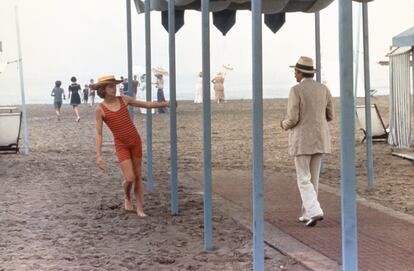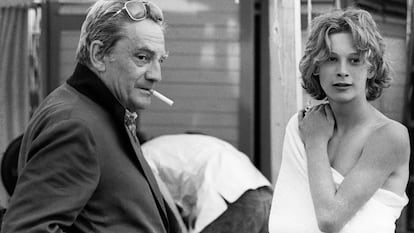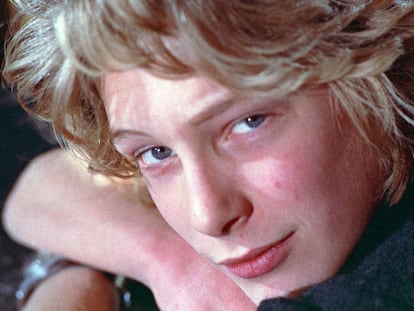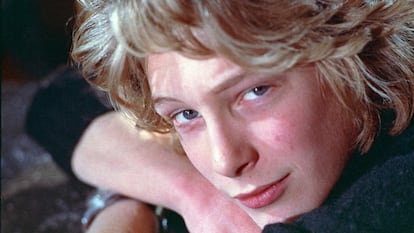The Swedish performer, who died at the age of 70, rose to fame at the age of 15 with Visconti’s film. A 2021 documentary illustrated how the film destroyed his life

Björn Andrésen, the Swedish actor and musician most famous for playing Tadzio, the young object of desire in Death in Venice He has died at 70 years old. His death, which occurred on Saturday, was announced in the Swedish newspaper Today’s News filmmaker Kristian Petri, co-director of The most beautiful boy in the worlda 2021 documentary about the actor’s fall into hell. The cause of his death has not been made public.
Andrésen was selected by Luchino Visconti in casting tests at the age of 15, when the filmmaker was looking for a beautiful, blonde protagonist for his film. Death in Venice adaptation of the novel of the same name by Thomas Mann. Andrésen played Tadzio, with whom an older man played by Dirk Bogarde becomes obsessed.
Hungary, Poland, Finland… Visconti had been searching for his perfect Tadzio for a long time and many miles across Europe. Mann described him as having a cold beauty like a statue and with eyes “the color of water”, a beauty that obsesses the composer Gustav von Aschenbach (played by Dirk Bogarde) when the two cross paths in a decadent Venice infected with cholera. The Italian filmmaker found him in Stockholm, after the parents of Miguel Bosé (Visconti’s godson) refused to allow him to participate in the film. He was the sixth boy—he had come pushed by his grandmother—who entered the room where the tests were carried out. A little older than expected (15 years old), a little taller than planned, but Visconti, at the film’s premiere in 1971 at the Cannes festival, confessed: “I had no doubt that it was him.” It didn’t take him a minute to ask her to undress in front of the camera.
And that is known because those images of a withdrawn, very shy teenager are shown in the documentary that Visconti himself filmed about his search. (At Tadzio’s research), and because that’s how the documentary starts The most beautiful boy in the world (2021), which recounts the pain suffered by Andrésen; half a century after his film debut, very thin, with long hair and a beard, he was still not able to look at the camera of filmmakers Kristina Lindström and Kristian Petri. By the way, the nickname of the most beautiful boy in the world also came from Visconti in that Cannes.
Trailer – The most beautiful boy in the world
n “}},”video_agency”:false,”alt_image”:”Trailer – The most beautiful boy in the world world”},”url”:”https://imagenes.elpais.com/resizer/v2/MLXCBU5I6BGA7GMDTDCNQDXNNQ.jpg?auth=b58d2248ffc 9ac3ffda32ab0c089495c3662e861160c214992a3e44c65ca4233&width=1200&height=675&smart=true”,”alt”:”Trailer – The most beautiful boy in the world”,”ogWidth”:16,”ogHeight”:9,”floating”:false});
Some time later, Andrésen recounted his negative experiences with Visconti and the world fame that came to him at the time. The Swede, for example, said that the Italian had taken him to a gay nightclub with a group of adults when he was only 16 years old. Andrésen, who was heterosexual, assured that he was not homophobic, but that the way he was treated there, at such a young age, made him feel “very uncomfortable,” as if he were “an appetizing plate of meat.” And that it was “the first of many meetings of this type.” By the way, once the promotion was over, Andrésen and Visconti never spoke again. In an interview in The Guardian In 2003, he claimed that the label of “the most beautiful” affected him personally and professionally: “I felt like an exotic animal in a cage.”
Andrésen was a fragile boy, shaped by the death of his father and the suicide of his mother when he was 10 years old, and by a grandmother obsessed with him being a famous actor, denying him his true pleasure: music. “I have never seen so many fascists and assholes as in cinema and theater. Luchino was the type of cultural predator who would sacrifice anything and anyone for his work,” he said in promoting the documentary about his life.

After the success of Death in Venice His grandmother decided that they would go to Japan, where the movie had been a huge success. “He thought he had a lot of talent and that he should be world famous,” he said painfully decades later. In Japan, within a few weeks, she recorded two pop songs and appeared in several advertisements. They drugged him during that time so that he wouldn’t slow down.
His ambition was to form a big band jazz But upon his return to Europe, he was pressured to accept other film roles. He was in Paris—treated like “a sexual object,” he says in the documentary—for a year, waiting for Malcolm Leigh to make a film, How Lovely Are the Messengers, a project that never materialized. “I can sum up my career in one word,” he said. “Chaos”.
Finally, he moved to live with his girlfriend in Copenhagen, in search of stability and a certain anonymity. However, Tadzio’s shadow constantly pursued him, almost ending his musical career, because a priori Nobody thought that a boy like that could have talent in this art.

Andrésen continued acting, appearing in more than 30 films and television series, most filmed in his native Sweden. “My career is one of the few that started at the top and then went down,” he said. “It was very lonely.”
He had two children with his ex-wife, the poet Susanna Roman: a daughter, Robine, and a son, Elvin, who died of sudden infant death syndrome at nine months of age. According to the court report, Andrésen was lying next to his son, drunk, when he died. After his divorce, the actor entered a period of depression and alcoholism.
When directors Lindström and Petri contacted him, Andrésen refused to be filmed. It took them five years to convince him and film him, to make “a film with him, not about him.” He lived in an apartment consumed by Diogenes syndrome, and only a girlfriend saved him from ruin. At least they were able to accompany him to the filming of Midsummer, by Ari Aster, where he appeared in a small role as an old man whose face is smashed with a mallet while being sacrificed in a pagan ceremony. Andrésen was delighted with the role: “Being killed in a horror movie is every child’s dream.”
Your subscription is being used on another device
Do you want to add another user to your subscription?
If you continue reading on this device, it will not be able to be read on the other.
Why are you seeing this?
Arrow
Your subscription is being used on another device and you can only access EL PAÍS from one device at a time.
If you want to share your account, change your subscription to Premium mode, so you can add another user. Each one will log in with their own email account, which will allow you to personalize your experience in EL PAÍS.
Do you have a business subscription? Go here to sign up for more accounts.
If you do not know who is using your account, we recommend changing your password here.
If you decide to continue sharing your account, this message will appear on your device and the device of the other person who is using your account indefinitely, affecting your reading experience. You can consult the terms and conditions of the digital subscription here.
About the signature

He is an editor of the Culture section, specialized in cinema. At the newspaper he previously worked on El Espectador and Tentaciones. He started on local radio stations in Madrid, and has collaborated in various film publications such as Cinemanía or Academia. He has a degree in Journalism from the Complutense University and a Master’s degree in International Relations.
More information



